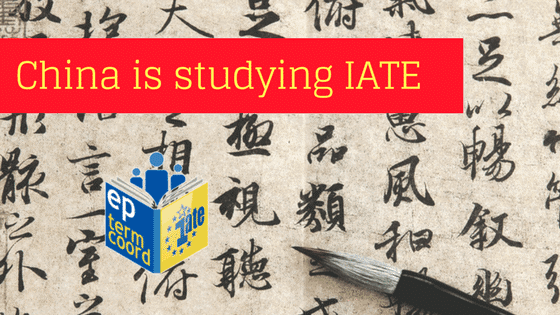
Hui Liu, who lectures at Nanjing University of Aeronautics and Astronautics, wrote this interesting paper, which was sent to us by Romanian Terminologist Dr. Georgeta Ciobanu. The paper discusses the IATE database and its functions. We are delighted to discover that IATE is being discussed in China and that international translators recognize its importance in the terminology world.
Methods and Significance of Institutional Terminology Management-A Case Study of IATE
By Hui Liu
Abstract: In the era of globalization, how to ensure the consistency and accuracy of terms in use is a problem that is worth our attention. For a long period of time, international institutions such as the European Union (EU) and the United Nations (UN) have been facing the problems of multilingual terminology use and management. Meanwhile, these institutions have also gathered some successful experience. This paper probes into the design, source, reliability, function and management of IATE, Inter-Active Terminology for Europe, and tries to provide some suggestions for institutions and researchers in this field.
Keywords: institutional terminology, terminology management, IATE
- Terminology Management and Terminology Management in Large Institutions
Terminology Management, which consists of collecting the terms, documenting the terms with appropriate metadata, and distribution and dissemination of terms (Li, 2014), is a part of quality assurance procedure (Ciobanu, 2016). In other words, terminology management is the systematic collection, description, processing, recording, storage, presentation and query of specific vocabulary in a specific field of expertise (Liang, 2012).
For institutions, terminology management not only helps their staff write better and clearer documents in less time, but it also helps translators produce high-quality and consistent translations[1]. In order to communicate effectively between departments within the same organization and among members, large institutions, especially those with multiple languages, usually attach great importance to terminology management. As a large institution with 27 member states and 24 official languages, the EU must ensure that the communication among its member countries is clear and consistent. Therefore, consistent terms are particularly important for the EU. Mr. Strandvik, Quality Manager at Directorate‐General for Translation, European Commission, has also expressed his concern about this problem and says that the terminology and the entries used by EU institutions must follow the principle, which is, each entry and term must have the same status in every official language. This undoubtedly shows the high requirements of the EU’s terminology management work.
[1] Terminology for Large Organizations, Terminology Starter Guide. Retrieved Jan. 29, 2017, from http://www.terminorgs.net/downloads/TerminOrgs_StarterGuide.pdf.
- Inter-Active Terminology for Europe
IATE (Inter-Active Terminology for Europe) is a proprietary terminology bank within the European Union that integrates all the existing termbanks from the EU’s language and translation service departments. IATE has been used for more than ten years since its establishment in summer, 2004. The project was initiated in 1999 with the aim of integrating the EU’s terminology resources and providing a web-based terminology repository for Europe to enhance the availability and standardization of information. IATE, which covers all the 24 EU official languages and now contains more than 8.7 million term entries in various fields such as law, economy and communication, includes approximately 540,000 abbreviations and 130,000 phrases[2]. Additionally, IATE incorporates new term entries frequently, and terms are maintained on a regular basis.
Project partners of IATE include European Commission, Council of the European Union, European Parliament, Court of Justice, European Court of Auditors, European Economic and Social Committee, European Committee of the Regions, European Investment Bank, European Central Bank and Translation Center for the Bodies of the European Union. IATE is managed and maintained by a number of EU institutions, including the European Commission, Council of the European Union and the European Parliament.
IATE consists of a public version and an intranet version that is available only to the EU’s internal agencies. Launched in June 2007, the public version and website of IATE are managed by the project partner, i.e. EU Translation Center in Luxembourg. At present, its daily average worldwide search frequency reaches 5,000 times per hour.
In addition, IATE has established an open academic cooperation mechanism and it cooperates with European universities to provide teachers and students with internal accounts to access the IATE internal termbase. Teachers and students can also contribute terms to IATE to gain experience in terminology and management.
[2] The EU’s Multilingual Term Base. Retrieved Jan. 29, 2017, from http://iate.europa.eu/brochure/IATEbrochure_EN.pdf.
2.2 Sources of Terms and Reliability
IATE integrates all the existing termbanks of the European translation service departments, including EURODICAUTOM, TIS, and EUTERPE. In addition, IATE incorporates terms and related information obtained from EU translators, administrative officials, experts, and other reliable sources that have been reviewed by EU terminologists and translators.
Terms in IATE are strictly rated based on the reliability which is divided into five levels with codes ranged from 0-4. The explanations of the codes are shown in Table 1.
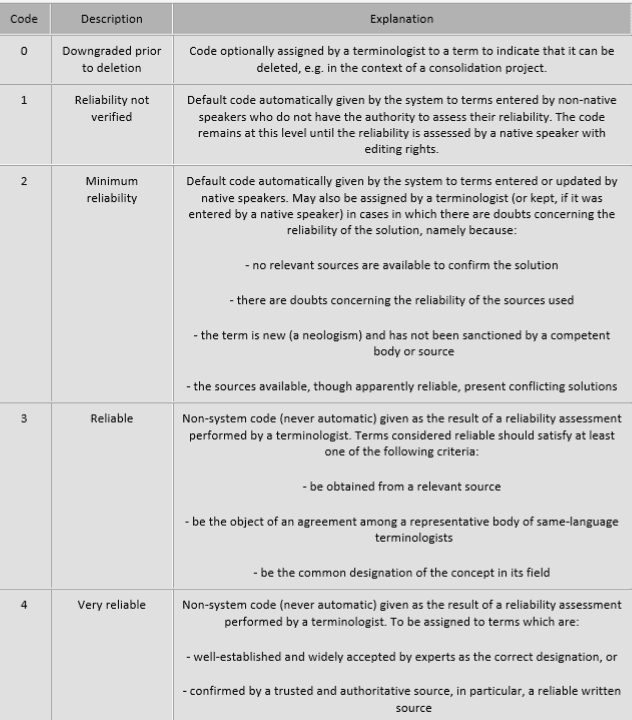
At present, most of the terms in IATE have a reliability code of 3 or 4, and there are also some terms with a reliability code of 1. This is because European Commission has a lot of term extraction tools, and term extraction together with the uploading is done on a regular basis. Terms that are simply uploaded by the system and are not provided with provenance or other relevant information usually have a reliability code of 1.
2.3 Functions
2.3.1 Search
Users can log onto IATE’s website (http://iate.europa.eu/) to search for terms (see Figure 1). Users can select the source language (e.g. “de” for German) and then search for terms in one or more target languages (in a specific field). Searches support wildcards.
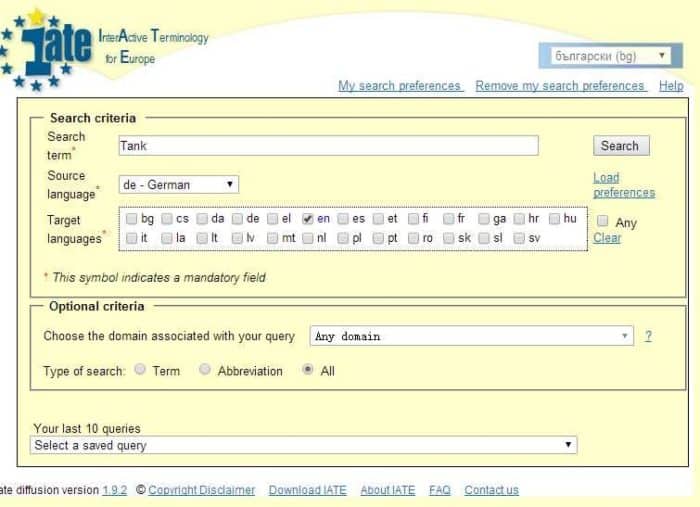
Take the search for the German term “Tank” as an example. The source language is set to be German and the target language English (see Figure 2). The results show that there are 417 terms that meet the search criteria. (The mark ![]() signifies that a reference is provided,
signifies that a reference is provided,![]() signifies that a definition is provided, and
signifies that a definition is provided, and ![]() signifies that a context is provided).
signifies that a context is provided).
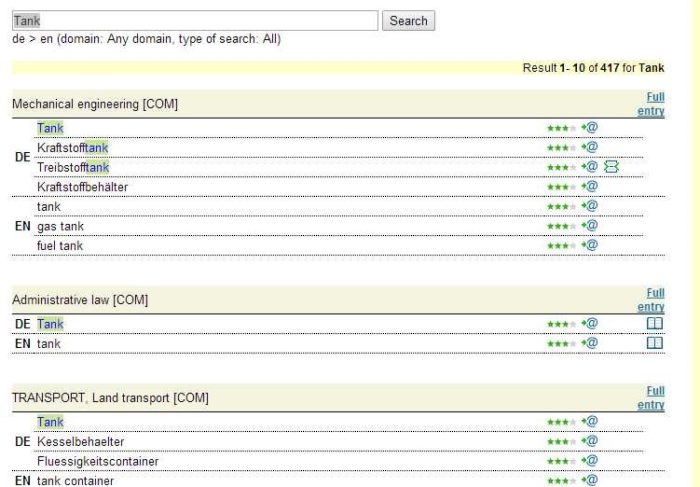
Click on a term, such as the third German term “Treibstofftank” in the field of mechanical engineering, all the information of the term is listed, including reliability, Term Ref., Context, Context Ref., Date, and so on (see Figure 3). In addition, users can click on the “feedback” button on the upper right corner to submit online feedback about this term or the search result.
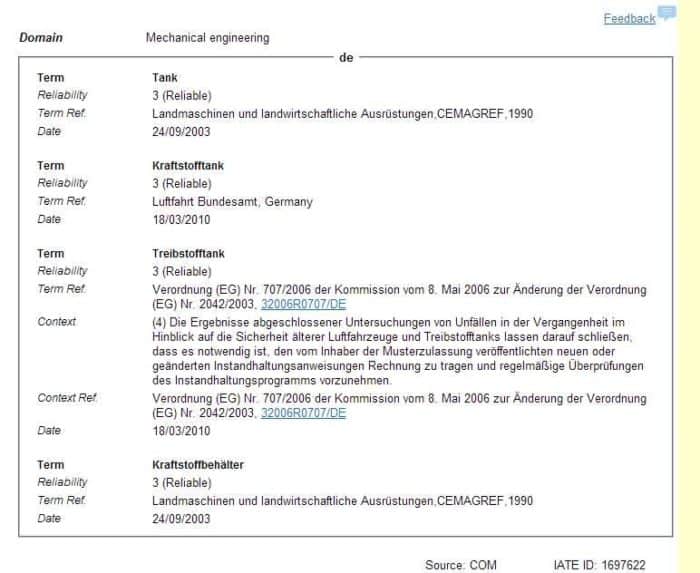
2.3.2 User Behavior Record
In order to facilitate the users to review the retrieved terms and relevant information, IATE automatically retains the latest 10 search results. Click “Select a saved query” at the bottom of the search page, users can view the saved query at any time. In addition, IATE supports the search preference records of source language(s) and target language(s), which can be automatically retained at the next search query (see Figure 4).
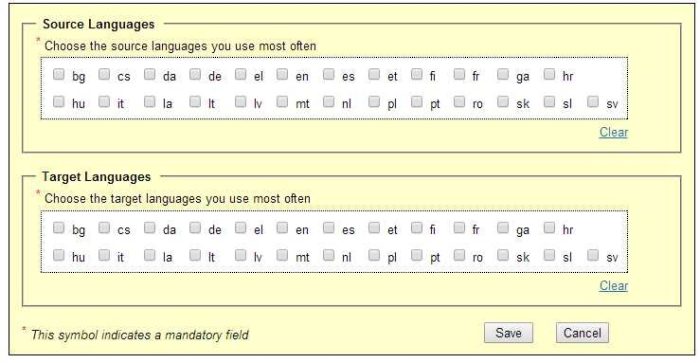
2.3.3 Termbase Download
IATE provides certain termbases for users to download and use. Terms downloaded are in TBX (TermBase eXchange) format[3]. Each term entry consists of three data categories, i.e. concept, language, and term. Information from the data category “concept” includes entry ID, subject domain and domain note; information from the data category “language” includes language code; information from the data category “term” includes term, term type, reliability code and evaluation (which is divided into four groups, namely, preferred, admitted, deprecated and obsolete). Term downloaded from IATE are generally reserved for research purposes.
[3] IATE Data Fields Explained. Retrieved Jan. 29, 2017, from http://iate.europa.eu/tbx/IATE%20Data%20Fields%20Explaind.htm.
2.3.4 Terminology Management and Audit
IATE provides EU agencies with a web-based interactive work environment to facilitate inter-agency collaboration. This interactive work environment consists of a central terminology database, a web server which enables remote consultation, data entry, and editing, as well as an application server for managing access rights and data, and the confirmation of workflow together with related information. The number of terminology experts in various institutions in the EU is different. For example, there are two full-time terminologists for each official language in the European Commission and four or more part-time terminologists for each official language. Besides that, there are also teams which provide technical support.
As mentioned earlier, the EU’s cooperative projects often lead to the discovery of new terms. In addition, new terms can be submitted by European Commission’s translators via e-mails or in EXCEL format. In terms of term review, the European Commission’s terminologists will consult field experts who are native speakers of that particular language (at present, most of the new terms come from the field of economics and IT). The duration of term audit varies from a few minutes to several weeks, depending on the term expert’s familiarity with the term and difficulty of the term.
3. Advantages and Disadvantages of IATE
As can be seen from the above discussion, features of IATE can be summarized as follows.
Firstly, IATE provides necessary functions and the information of term entries can be further enriched. Currently, IATE mainly provides the search function. I find that the information of many terms of IATE is restricted to reliability, reference information and creation date. Compared with the information of terms stored in termbases used by enterprises, information provided by the public version of IATE can be enriched. Of course, adding features and information will inevitably increases maintenance costs. Considering the free nature of the public version of IATE and the number of languages involved, it will be a problem to consider.
Secondly, terms of IATE are rigorously categorized according to reliability. Management of the termbase also requires certain authorities. At present, reliability of most of terms in IATE is coded 3 or 4. Being an international termbank, categorization of term reliability guarantees the authority and reliability of terms as well as relevant information. What’s more, as the public version of IATE only provides the search function, ordinary users cannot modify any information. As a result, security of the data is ensured.
Thirdly, good interaction plus search records and preferences can be kept without registration. Unlike current commercial and some free termbases, users of IATE can access the public version without registration and IATE automatically retains the latest 10 search results as well as search preferences from users. Users can also submit feedback online to the management team, realizing ease of use and better interaction.
Fourthly, there is not yet a study on the frequency concerning term use of IATE. Consisting of more than eight million terms, IATE covers a variety of areas such as law, agriculture, and IT. However, such a large database is not equipped with studies concerning the use and search of individual terms. Consequently, the importance of terms cannot be analyzed, which means that terms in IATE can only be added, not deleted. Taking into account the cost of long-term data maintenance, certain waste of resources can be predicted.
4. Significance and Thoughts
Managing terminology can avoid duplication of labor and a waste of resources to a certain extent, and it can reduce the risks brought about by possible inconsistent terms, thus improving text quality and ensuring the accuracy of the translation (Wang, 2015). Therefore, the IATE termbase plays an important role in guaranteeing the quality of communication in EU institutions. Although there are some shortcomings, IATE provides us with meaningful thoughts, especially after China launched the “Termonline Platform[4]” which provides users with such functions as search, share, correct and more than 450,000 bilingual (Chinese and English) terms in over 100 disciplines including engineering, technical science, agriculture, medicine, military science, and humanities and social sciences. Under each discipline follows sub-disciplines, thus establishing a convenient knowledge navigation mechanism. Termonline uses the advanced DISE (Data Intelligent Search Engine), and provides search association reminders, personal sorting algorithms, etc. Despite of its advantages, it should also be pointed out that Termonline also needs to be improved. To start with, although it covers a large number of disciplines, terms in certain disciplines are urgently in need of adding; secondly, despite of the fact that term entries can be ranked in various ways, there is no reliability classification of terms; thirdly, data categories of terms are not yet sufficient, they currently only include definition, provenance, and creation date. As a result, subsequent development of Termonline needs to draw on the experience of large institutional terminology databases including IATE (e.g. the design and categorization of reliability) so as to add term entries, expand term creation channels, and develop new functions (e.g. keeping search records and preferences).
[4] See http://www.termonline.cn/index.htm.
- Ciobanu G. (2016, July). Why Terminology Management? Presentation presented on International Terminology Summer School, Vienna.
- IATE Input Manual. Retrieved Jan. 29, 2017, from https://iate.cdt.europa.eu/iatenew/help/input.html.
- Li, D., et al. (2014). Introduction of IATE in EU and Termium in Canada. China Terminology (6):14-17.
- Liang, A. (2012). Importance and Role of Terminology Management-Case Study of the Terminology Management Strategy from the Microsoft Company. China Terminology (5): 10-14.
- Wang, H. (2015). Terminology Management in Scientific Translation. China Terminology (4):17-21.
Hui Liu (corresponding author)
Nanjing University of Aeronautics and Astronautics
No. 29, Jiangjun Road, Jiangning District
211106 Nanjing, Jiangsu Province, P.R.C.

